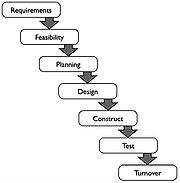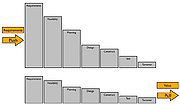Waterfall vs. Pull Processes
(→Waterfall vs. Pull) |
(→Pull Process) |
||
| Line 39: | Line 39: | ||
=Pull Process= | =Pull Process= | ||
By adding out of scope functionalities, you can expect that it will impact negatively your project triple constraint. If you make more work than required at a certain time, it will be pilled in waiting to be expedited to the next step. You should also avoid here to execute project management activities in a batch. Indeed if there is any product change request then you would end up with obsolescence and therefore waste. | By adding out of scope functionalities, you can expect that it will impact negatively your project triple constraint. If you make more work than required at a certain time, it will be pilled in waiting to be expedited to the next step. You should also avoid here to execute project management activities in a batch. Indeed if there is any product change request then you would end up with obsolescence and therefore waste. | ||
| − | [[File:Pull Process.jpg| | + | [[File:Pull Process.jpg|thumb|The pull process]] |
The challenge here is to avoid delivering value before the customer request it. Also you should not provide to the customer more than the agreed initial scope. In manufacturing, we let the customer pulling the flow by means of a Kanban system. Kanban allows the implementation of a just-in-time system. It uses cards to signal the need for an item by triggering the movement, production, or supply of a unit. | The challenge here is to avoid delivering value before the customer request it. Also you should not provide to the customer more than the agreed initial scope. In manufacturing, we let the customer pulling the flow by means of a Kanban system. Kanban allows the implementation of a just-in-time system. It uses cards to signal the need for an item by triggering the movement, production, or supply of a unit. | ||
==Pros== | ==Pros== | ||
Revision as of 23:10, 25 February 2018
There are many different methodologies of project management, all of them are defined by different principles and processes. A traditional, sequential methodology, is the Waterfall model. Within this model, the tasks of the project plan are sequenced and conducted in a linear way, one task must be completed before the next one begins - the process is smooth and continuous, like a waterfall. Therefore, this model is one of the simplest methods. However, the pull process-based methodologies are used to create the whole project plan more efficient and effective, it was created to eliminate confounding factors within the project, but it is more complex due to the consideration of many influences. This article provides an introduction to both methodologies, a comparison with pros and cons and a guidance how to select the right methodology for the practical usage.
Contents |
Importance for Project Management
Project Manager's world is about focusing on the product, focusing on the team, keeping the customer happy. Project managers face here a serious challenge. In addition, they have to deal with a matrix organization, with people that they don't have power on.
Project management processes and the lean six sigma tools kit would certainly help project managers become more efficient by focusing on value added activities and limiting processes variation. In real life, project managers overlooked the following:
Establish real Customer Value: Set up a scope baseline control to avoid our baseline to creep. Build a communication plan to streamline the information flow Assess stakeholder needs and get internal stakeholder commitment Define Project Value Stream When those previous factors get overlooked then project wastes start building. What happen if we are not collocated with our customer? Then it could be really difficult to establish real customer value. If we allow our customer to redirect our project team member then we would end up with scope creep.
Normally, our project management plan should describe the project value stream. The Work Breakdown Structure would decompose end deliverables into value-added work package and value-enabling work package. The precedence diagram network would make the value flow. First it is recommended to have an unconstraint approach. The project manager would then negotiate with the customer to which extent planned milestones could be pulled but customer target milestones. If we accept up front customer's constraints without any proper practical and logical planning effort, we would then certainly start building wastes and increase cost.
We have a good project management plan so why are we in trouble? We have to re-plan the project and finally we face schedule and budget overruns. Let's discover now how Lean principles can be applied to project management processes.
Waterfall Process
The waterfall process...
Requirements
Feasibility
Planning
Design
Construct
Test
Turnover
Pros
Cons
Pull Process
By adding out of scope functionalities, you can expect that it will impact negatively your project triple constraint. If you make more work than required at a certain time, it will be pilled in waiting to be expedited to the next step. You should also avoid here to execute project management activities in a batch. Indeed if there is any product change request then you would end up with obsolescence and therefore waste.
The challenge here is to avoid delivering value before the customer request it. Also you should not provide to the customer more than the agreed initial scope. In manufacturing, we let the customer pulling the flow by means of a Kanban system. Kanban allows the implementation of a just-in-time system. It uses cards to signal the need for an item by triggering the movement, production, or supply of a unit.
Pros
Cons
Waterfall vs. Pull
Waterfall vs. Pull


